Jump to:
Picture a wall adorned with a vibrant tapestry of cascading greenery. A living masterpiece that embraces nature’s vertical canvas — cue vertical gardening.
This planting method revolutionises the way we bring nature into our urban environments. It offers a refreshing solution for indulging green thumbs without compromising on space.
This post focuses on one aspect: the selection of the best plants for your vertical garden. Each is chosen for its ability to thrive and enhance the beauty of your living wall. Ready to elevate your gardening prowess to new heights?
Benefits of Vertical Gardening
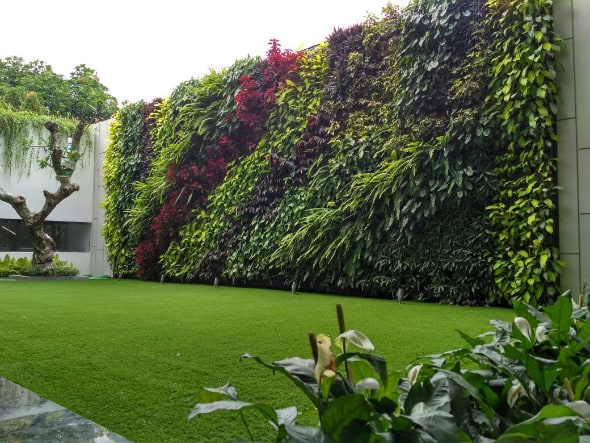
(Image Credit: Wikimedia Commons)
To start, it optimises space utilisation. Vertical gardens allow you to make the most of vertical surfaces, e.g. walls, fences, or trellises. This especially comes in handy in urban environments where land is limited.
By going vertical, you transform unused spaces into lush, green sanctuaries. This can add a touch of natural beauty to previously overlooked areas.
Another remarkable benefit is its ability to expand your plant selection. This opens up opportunities for you to grow a wide variety of plants that may not have been possible in horizontal gardens.
Vertical gardens also go beyond their aesthetic appeal. They act as natural air purifiers, filtering pollutants and capturing dust particles. Thereby improving air quality. On your part, you contribute to reducing the carbon footprint.
What’s more, vertical gardens help bring nature back into the ‘concrete jungle’. They provide habitats for beneficial insects and birds, promoting biodiversity in urban areas.
Vertical gardening presents an innovative and sustainable approach that embraces beauty and functionality.
Factors to Consider for Vertical Gardens
1. Sunlight
Assess the amount and quality of sunlight available in the chosen area. Different plants have varying light requirements. It’s crucial to select plants that thrive in the available light conditions.
2. Space availability
Consider the available space for your vertical garden. Assess the vertical surface area and ensure it can fit the desired number of plants. Take into account any potential obstructions or limitations that may affect plant growth.
3. Watering requirements
Evaluate the plants’ watering needs you plan to include in your vertical garden. Vertical gardens may have different watering requirements than traditional gardens. For one, due to factors like drainage and water retention. Choose plants that can tolerate the specific watering conditions of your vertical garden.
Top Plant Picks for Vertical Gardens
1. Pothos

Pothos is a trailing vine known for its heart-shaped leaves in various shades of green. It’s a low-maintenance plant that can adapt to different light conditions. It can grow several feet long, creating a lush and cascading effect in a vertical garden.
Its vigorous growth habit makes it an excellent choice for vertical gardening. Even better, its air-purifying qualities can help improve indoor air quality.
Care tips and maintenance:
- Although it can tolerate low light, it may exhibit slower growth. It thrives best in bright, indirect light.
- Pothos prefer slightly moist but well-draining soil.
- Prefers temperatures between 60-85°F but can tolerate slightly cooler or warmer conditions.
- Trim the vines to control their length and promote bushier growth.
2. English Ivy

English Ivy is an evergreen climbing vine with distinctive lobed leaves. It comes in various cultivars with different leaf shapes and variegation patterns.
Its trailing habit allows it to cover vertical surfaces, walls, or trellises effectively. It can also develop dense foliage that creates an elegant and lush appearance. This, in return, provides privacy, reduces noise, and acts as a natural insulator.
Care tips and maintenance:
- Keep the soil consistently moist but not soggy.
- English Ivy prefers bright, indirect light but can tolerate partial shade.
- The plant prefers cool to moderate temperatures ranging from 50-70°F (10-21°C).
- Regular pruning helps maintain the desired shape and control growth.
3. Clematis
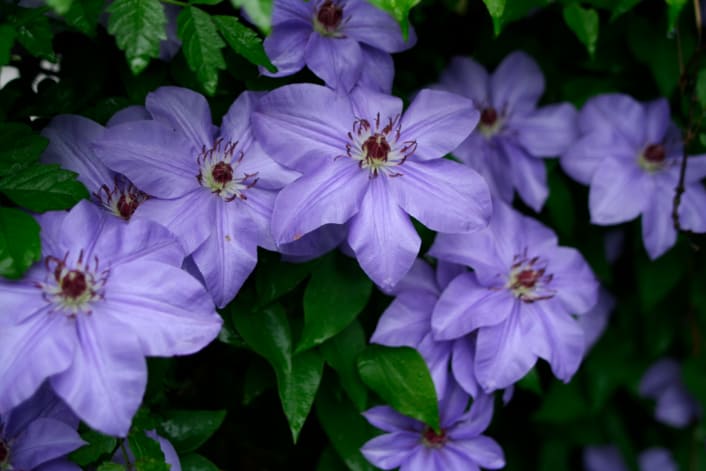
(Image Credit: Wikimedia Commons)
Clematis is a versatile flowering vine known for its stunning, showy blossoms. It comes in a variety of colours and flower shapes, ranging from single to double blooms.
Its ability to cover vertical structures such as trellises, fences, or pergolas. Their climbing growth habit can add vertical interest and a burst of colour to your garden.
Care tips and maintenance:
- Provide consistent moisture by watering regularly.
- Ensure they receive at least six hours of sunlight per day for optimal flowering.
- Install a sturdy trellis or other support system for the clematis vines to climb.
4. Spider plant
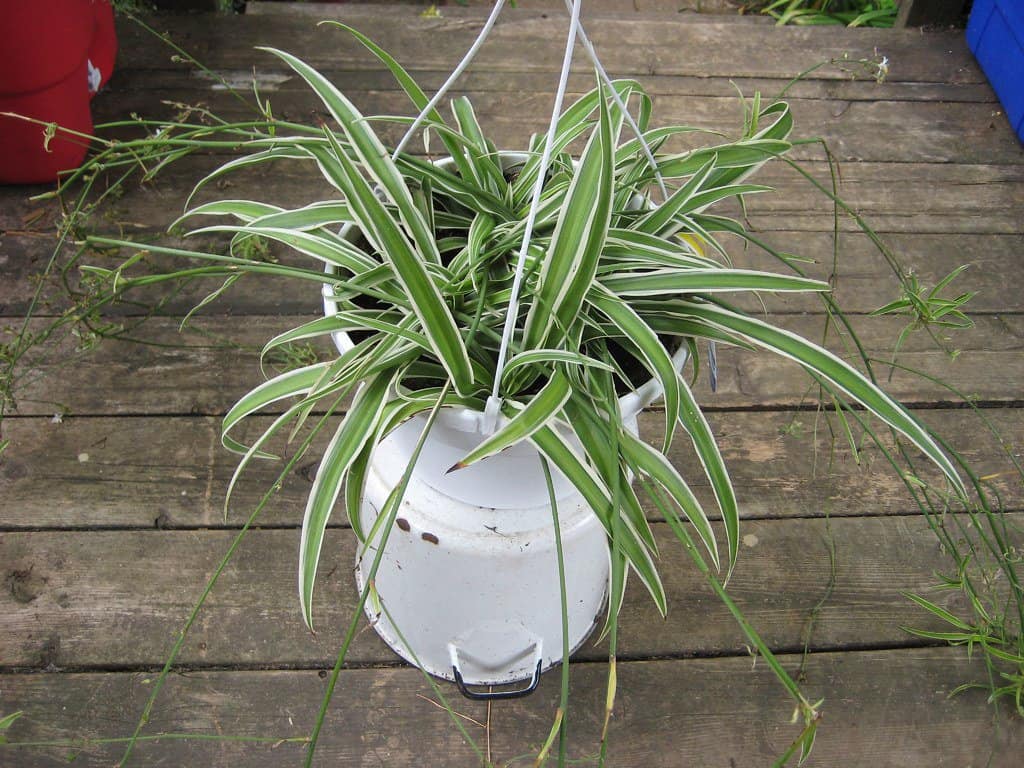
Spider plants are popular houseplants with long, arching leaves that feature white stripes. They produce small plantlets that dangle from long stems, resembling spiders.
They make an excellent choice due to their cascading growth habit and adaptability. Spider plants can be grown in hanging baskets or mounted on walls.
Care tips and maintenance:
- Allow the soil to dry out between waterings.
- Spider plants prefer bright, indirect light but can tolerate lower light conditions.
- The plantlets can be rooted in water or planted directly into well-draining soil.
5. Morning Glory
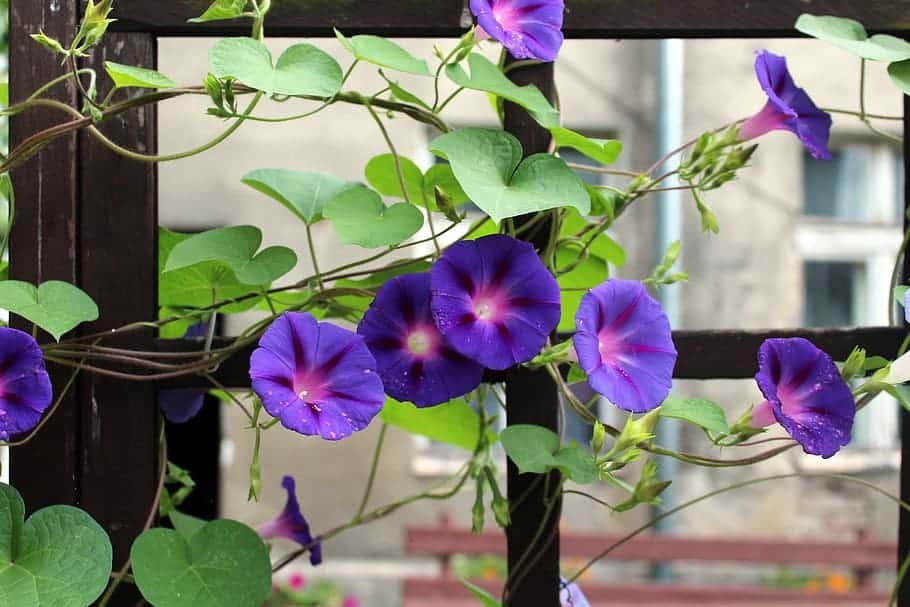
(Image Credit: Wallpaper Flare)
Morning Glory is a fast-growing annual vine renowned for its vibrant, trumpet-shaped flowers. It has heart-shaped leaves and twining stems that can cover vertical structures. It also attracts pollinators like bees and butterflies.
Care tips and maintenance:
- It thrives in full sun, requiring at least six hours of direct sunlight per day.
- Install a sturdy trellis, fence, or other vertical structure for support.
- Provide regular watering to keep the soil evenly moist but not waterlogged.
6. Ferns

(Image Credit: Wallpaper Flare)
Ferns are non-flowering plants that are known for their feathery, delicate fronds. Their lush foliage and graceful fronds add a touch of elegance. Also, offer a contrasting texture when combined with other plants in vertical displays.
Care tips and maintenance:
- Ferns prefer indirect or filtered light, so avoid exposing them to direct sunlight.
- Feed with a balanced, water-soluble fertiliser during the growing season.
7. Wandering Jews
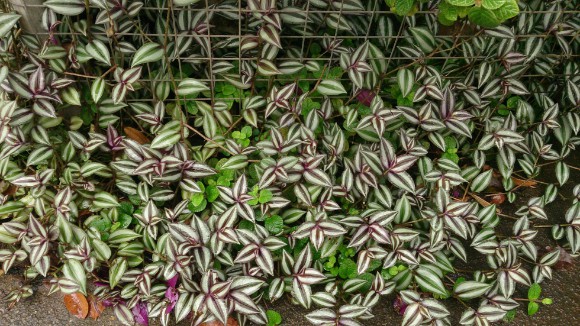
(Image Credit: Wikimedia Commons)
Wandering Jew is a trailing plant with striking purple and green leaves. It features long and vining stems that easily cascade down from climb-up structures. Its trailing growth habit and eye-catching foliage make it ideal for vertical gardens.
Care tips and maintenance:
- Wandering Jew prefers bright, indirect light but can tolerate lower light conditions.
- Regularly pinch back the tips of the stems to promote bushier growth.
- Cut a healthy stem below a node and place it in water or moist soil until roots develop – for propagation.
Round-up
Vertical gardening offers a space-efficient way to bring nature’s beauty into your surroundings. By carefully considering the factors above, you can create a thriving vertical garden. Remember to provide proper care to ensure the success of your vertical garden. Embrace the possibilities and let your garden climb to new heights!





